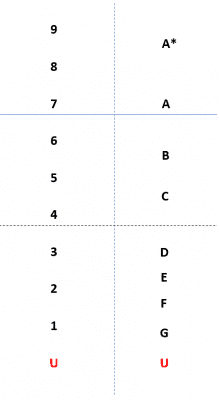The GCSE grading system is changing, starting from this year. Keep reading to find out about the new GCSE grading structure, what these changes are so you can prepare your child for their upcoming GCSEs, and how to make sense of their results in the mock tests and real exams.
As of 2017, the British government is reforming the GCSE grading system. If you cast your mind back to when you did your own GCSEs, you’ll likely remember that you were graded between A* and G, with A* being the highest grade and G being the lowest. As of this year, the ‘lettered’ A*-G system is to be replaced with numbers, ranging from 9 to 1. 9 is the highest grade that candidates can achieve, and 1 is the lowest. In addition, GCSE content is set to get more difficult over the coming years.
New GCSE Grading Structure – What Will The New Grading System Look Like?
Up until this year, the GCSE grading system has been denoted using letters from A* (highest) to G (lowest). In 2017, this will start to change. The numbered system will now range from 9 (highest) to 1 (lowest). Here’s a diagram of how the old scores compare to the newer ones:

How Will This Affect My Child’s Grades?
As you can see, a level 9 is slightly higher than an A*. This is representing how a level 9 will be more difficult to achieve than an A* in the current system. A level 8 is the equivalent of a mid to high A grade, whilst a level 7 is basically the exact equivalent of an A.
What’s also noteworthy is how the C grade is now split between levels 4 and 5. This suggests that a level 4 is the equivalent of the old C grades, but that a level 4 is a ‘low C’. The black dotted line indicates where the bottom of the old C grade is.
This new system seems to be in use so that there can be greater distinction within the grades. For example, a lot of people get C grades at GCSE, but there’s a big difference between a ‘high C’ and a ‘low C’. Likewise, splitting an A into two separate grades (7 and 8) means that employers, schools, and universities can more easily distinguish between higher A grades and lower ones.
The government has also made it clear that level 9s will be less common than A*s. This is presumably an attempt to make GCSE content more challenging at higher levels, ensuring that the top possible grade truly represents the most committed students.
Finally, the government has stated that approximately the same proportion of students who achieve Cs in the old system will get level 4s in the new structure.
New GCSE Grading Structure – When Will These Changes Happen?
While these new grades won’t come entirely into effect for a few years, the process will be starting in 2017. This year, English Literature, English Language, and Maths will use the numbered grading structure. In 2018, 20 more subjects will transition to the new system. This means that your child might get a mix of lettered and numbered grades if they are taking GCSEs in 2017 and 2018. The aim is to transition subjects each year.
New GCSE Grading Structure – Conclusion
The new GCSE grading structure is quite straight-forward, and you shouldn’t worry about it negatively impacting your child’s GCSEs. However, it’s important to keep the following in mind:
1. Level 9s aren’t quite the equivalent of an A*, even though they are both the highest possible grade in their respective structures. Level 9s will be less common than A*s, which might make them a lot more valuable to employers.
2. Not every subject will switch to the new GCSE grading structure this year. English Literature, English Language, and Maths will move to the new system this year, and the rest will roll out in subsequent years.
3. In the new GCSE grading structure, 9 is the highest grade you can get, whilst 1 is the lowest.
If you’re looking for guides to help your child improve their chances of success at GCSE, take a look at our range of GCSE study guides.
Wow very good
Hi Amjad,
We’re super glad you found this useful!
Sincerely,
The How2Become Team